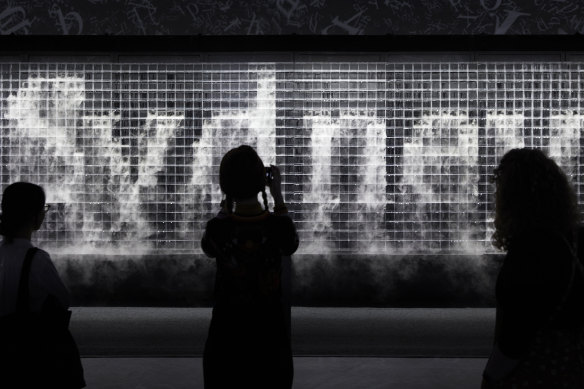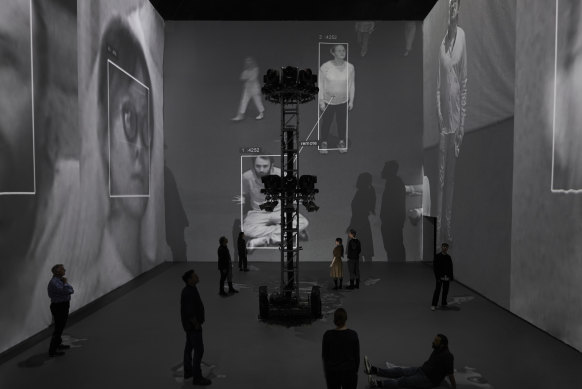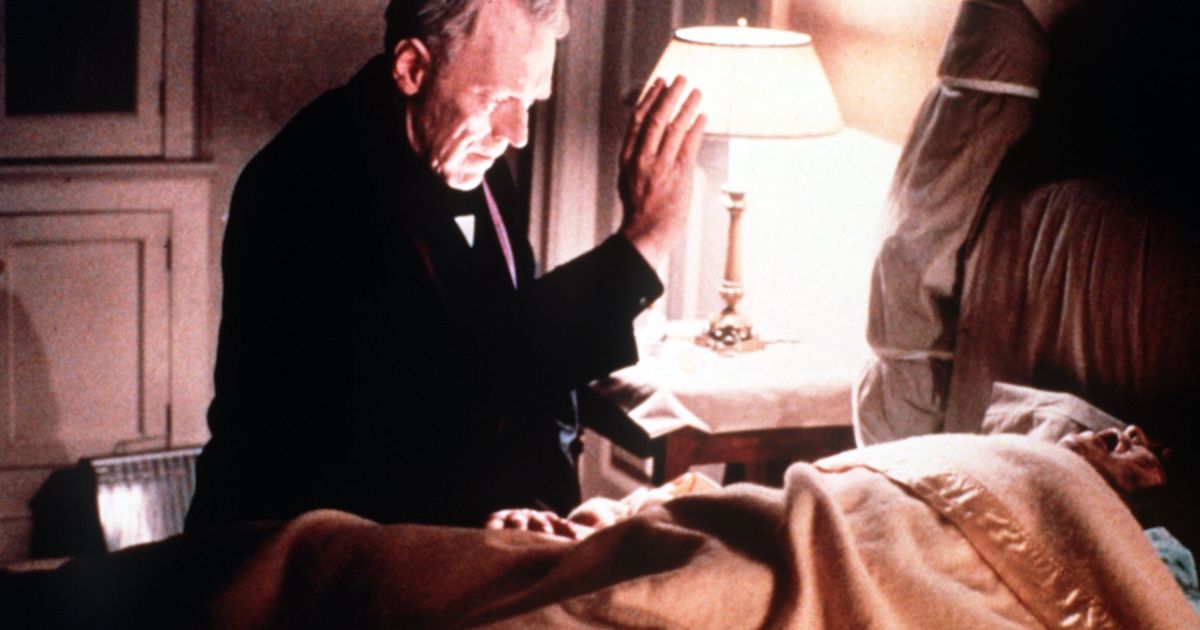Save articles for later
Add articles to your saved list and come back to them any time.
You may get the unsettling feeling you’re being watched at Rafael Lozano-Hemmer’s new show at the Powerhouse Museum. That’s because you are.
Tracking technology, facial recognition and more are all at play in Atmospheric Memory, the Mexican Canadian artist’s latest exhibition, which is designed to make air into something tangible.
Rafael Lozano-Hemmer’s Atmospheric Memory opens at Powerhouse Ultimo this week.Credit: Janie Barrett
The ideas link back to the work of Charles Babbage, the 19th-century British polymath credited with inventing the first computer.
“In his Ninth Bridgewater Treatise he talks about this moment that I’ve always been fascinated with, which is that as we speak, we create a turbulence in mid-air,” Lozano-Hemmer says. “For [him] the atmosphere is a vast library that contains everything everybody has said.”
Babbage wanted to harness everything spoken in the past. It may sound poetic, but encompasses the ugly side of history too.
“[He mentioned] slave owners getting away with murder,” Lozano-Hemmer says. “All of their deeds are being recorded in the atmosphere, and one day we’ll be able to find evidence of wrongdoing and seek justice.”
There’s always a much bigger story at play in Lozano-Hemmer’s work. “How often do you go to an immersive show and have these beautiful little butterflies and flowers and stuff, while the real butterflies and flowers are being decimated?” he says.
For him, immersive pieces can be ambiguous, and unique to each individual. “It lets you set up the artwork as a platform for something surprising to emerge. The artwork is successful if people make it their own.”
We, the public, are the final pieces of each puzzle: “I’ve often said that my work is incomplete and out of control.”
In the exhibition, you’ll find machines that turn speech into water ripples (Voice Tank), and one spectacular work that takes spoken words from the public and transforms them into three-dimensional water mist (Cloud Display).
Cloud Display by Rafael Lozano-Hemmer, at Powerhouse Ultimo.Credit: Zan Wimberley
For Field Atmosphonia, 3000 tiny speakers play field recordings to create an immersive cacophony. “Imagine if we could hear all the sounds of the past, what would that sound like? So we have this multichannel experience that is quite overwhelming,” Lozano-Hemmer says.
The large Atmospheres chamber brings together several pieces, including giant video projections on the walls and ceiling. It’s here where you might find yourself tracked.
Created in collaboration with artist Krzysztof Wodiczko, Zoom Pavilion is inspired by the restrictions Wodiczko experienced growing up in communist Poland, where public gatherings were forbidden.
“It detects you with 24 cameras, it measures you in relationship to everybody around you, determines if that’s suspicious,” Lozano-Hemmer says.
Zoom Pavilion by Rafael Lozano-Hemmer, at Powerhouse Ultimo.Credit: Zan Wimberley
Other pieces include Volute 1, which presents the world’s first 3D speech bubble (Lozano-Hemmer and his team used a laser tomograph and photogrammetry to capture voice waves in aluminium), and Babbage Nanopamphlets, a vessel containing Babbage’s treatise printed on pieces of gold just 150 atoms thick.
Here air, thoughts and sounds, from weighty to miniscule, command attention. “The most important message is we can’t take the atmosphere for granted,” Lozano-Hemmer says. “It’s the battleground for our survival on the planet.”
It’s this balance between the playful and pointed that defines Lozano-Hemmer’s work.
Powerhouse chief executive Lisa Havilah says, “Rafael has a distinctive and unique ability in his work to immerse and engage us with the complexity of science and the wonders of the world.”
Field Atmosphonia by Rafael Lozano-Hemmer, at Powerhouse Ultimo.Credit: Zan Wimberley
Lozano-Hemmer collaborated with the museum to ensure Indigenous stories and history were part of the exhibition, including artists and composers and artefacts from the museum’s collection. “The way in which we’ve integrated that Indigenous knowledge is very spread out, and I love that,” he says.
There are plenty of mesmerising moments (those “butterflies and flowers”) in Atmospheric Memory, but you’ll need to take a second to consider why they’re there.
“You’re part of it. You’re included, you’re doing selfies,” the artist explains. “But then it’s also the violence of the moment that we live in.”
Atmospheric Memory is at Powerhouse Ultimo until November 5.
The Booklist is a weekly newsletter for book lovers from books editor Jason Steger. Get it delivered every Friday.
Most Viewed in Culture
From our partners
Source: Read Full Article






